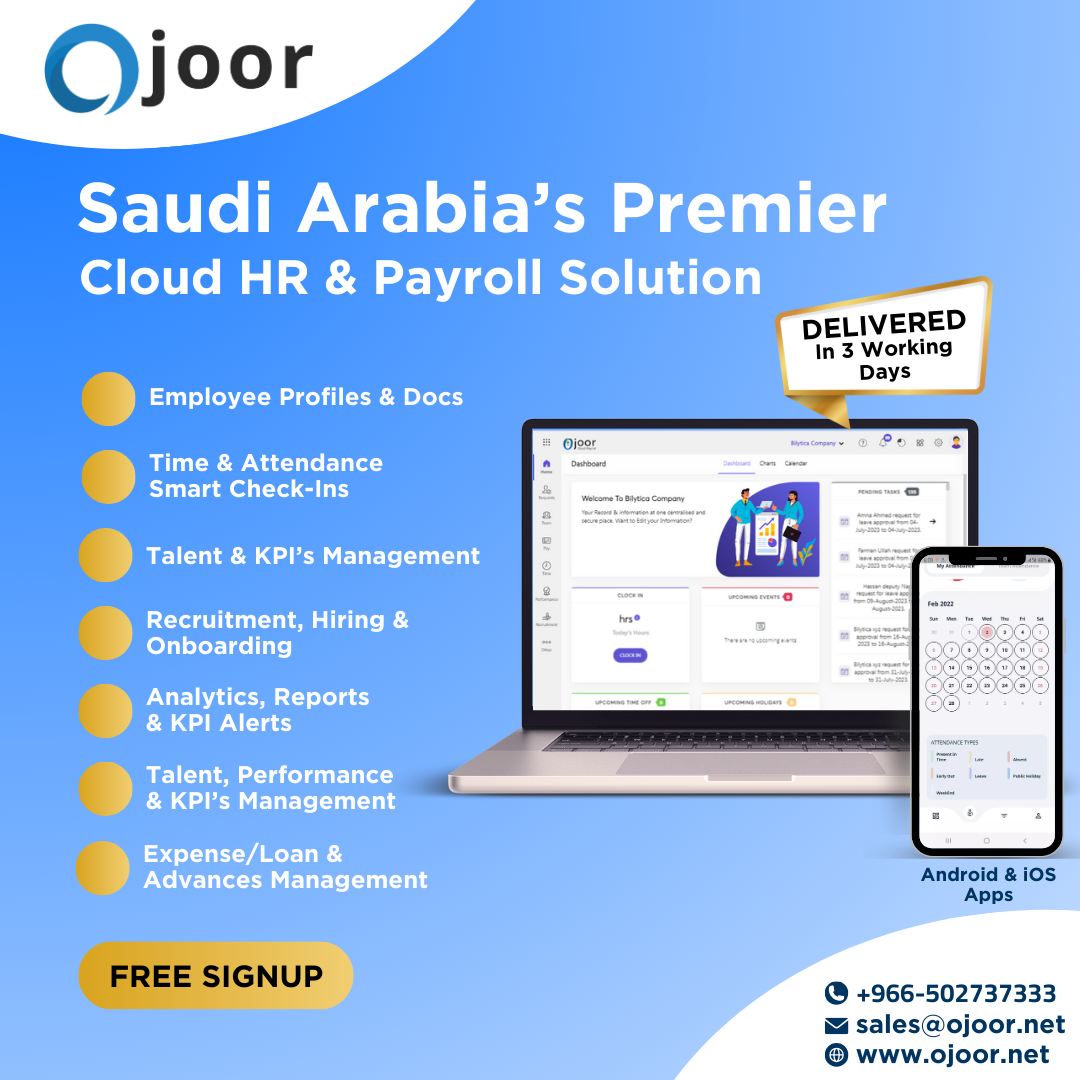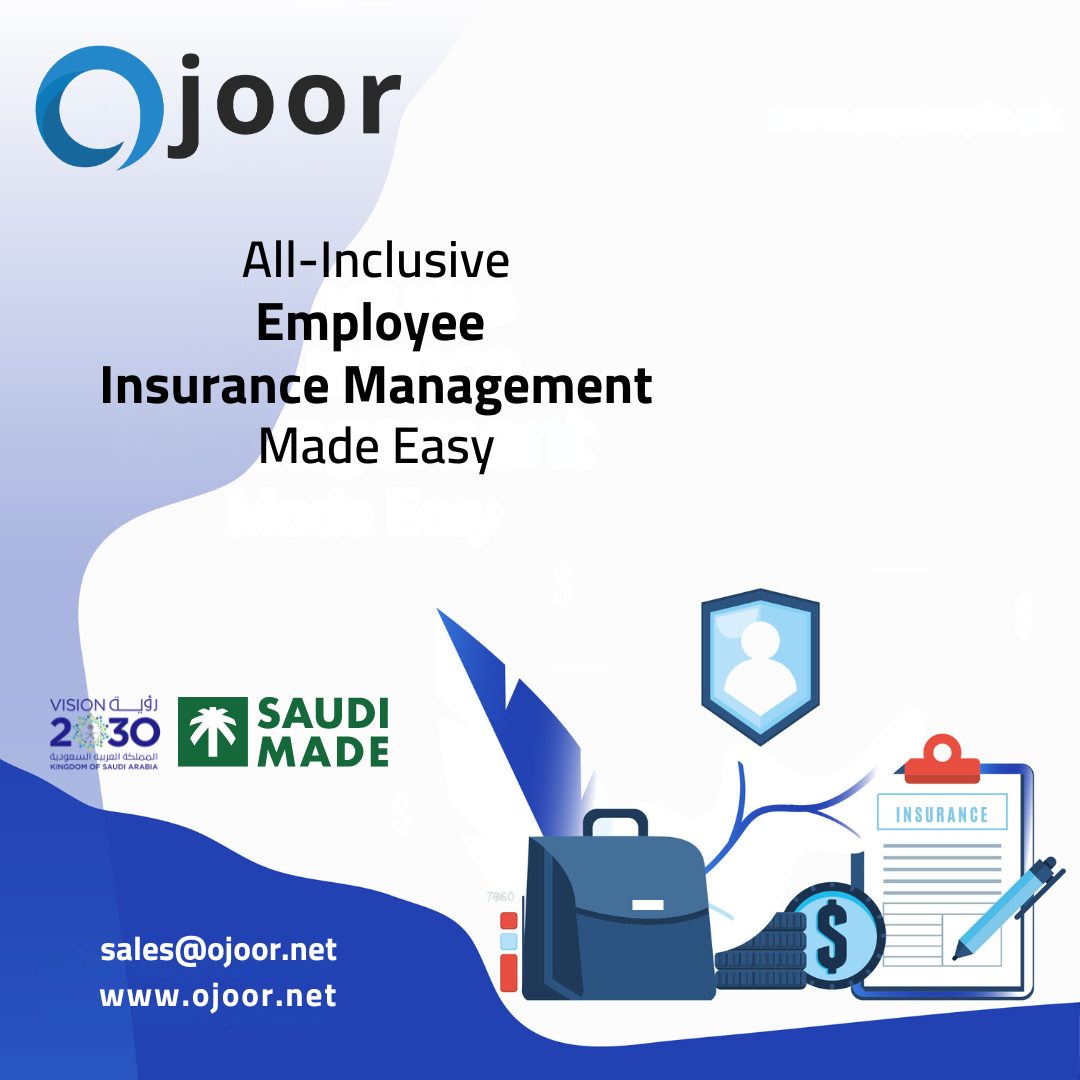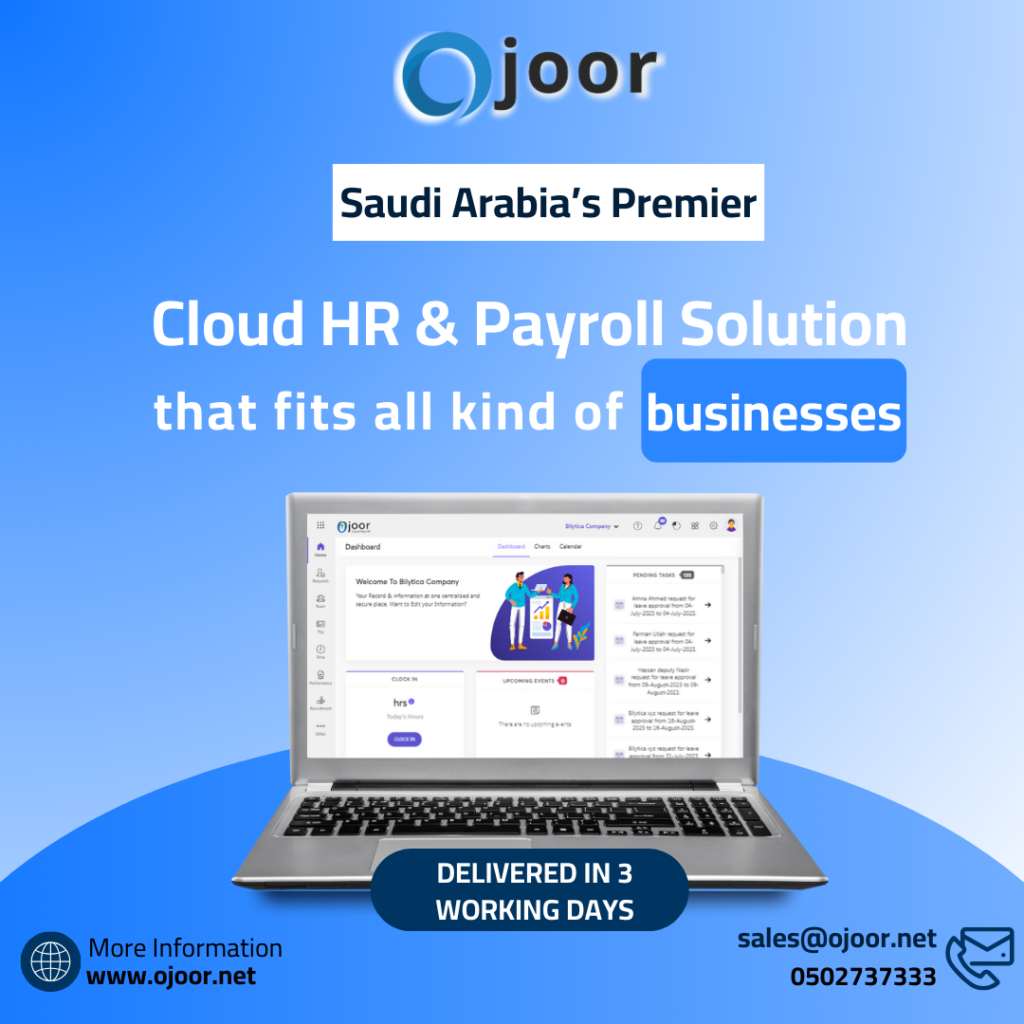Ojoor # 1 is one of the top HR System in Saudi Arabia essential in facilitating employee training and development, addressing the need for continuous skill enhancement, and ensuring that the workforce is well-equipped to meet the evolving demands of the market. These systems help organizations manage and streamline various aspects of employee development, from identifying skill gaps and delivering training programs to tracking progress and evaluating outcomes. This essay explores how HR systems in Saudi Arabia facilitate employee training and development, focusing on their key features, benefits, and challenges.
Click to Start Whatsapp Chatbot with Sales
Mobile: +966547315697
Email: sales@Ojoor.net
Ojoor #1 HR System in Saudi Arabia

Identifying Training Needs
Skill Gap Analysis
HR System in Saudi Arabia a crucial role in identifying skill gaps within the workforce by analyzing performance data, employee competencies, and organizational requirements.
- Performance Evaluations: Regular performance evaluations help HR systems identify areas where employees may need additional training.
- Competency Mapping: By mapping employee competencies against job requirements, HR systems can pinpoint specific skills that need development.
Employee Feedback
Gathering feedback from employees through surveys and assessments helps HR systems understand individual training needs and preferences.
- Surveys and Questionnaires: Conducting regular surveys allows employees to express their training needs and areas for improvement.
- Self-Assessments: Employees can conduct self-assessments to identify their strengths and weaknesses, which can be used to tailor training programs.
Designing and Delivering Training Programs
Personalized Learning Paths
HR systems in Saudi Arabia can create personalized learning paths based on individual employee needs, career goals, and performance data.
- Customized Training Modules: Tailored training modules address specific skill gaps and career aspirations of employees.
- Adaptive Learning: AI-driven HR systems can adjust the content and pace of training programs based on individual learning styles and progress.
E-Learning and Online Training
With the rise of digital technology, e-learning platforms integrated into HR systems offer flexible and accessible training solutions.
- Virtual Classrooms: Online training sessions and virtual classrooms allow employees to learn from anywhere, at any time.
- Interactive Content: Engaging and interactive training content, such as videos, quizzes, and simulations, enhances the learning experience.
Tracking and Assessing Training Effectiveness
Progress Monitoring
HR systems provide tools for tracking employee progress throughout their training programs, ensuring they stay on track and achieve their learning objectives.
- Learning Management Systems (LMS): An HR System in Saudi Arabia tracks course completion, progress, and performance, providing real-time updates to both employees and managers.
- Performance Dashboards: Interactive dashboards display key metrics related to training progress, making it easy to monitor and manage employee development.
Evaluating Training Outcomes
Assessing the effectiveness of training programs is essential for continuous improvement and ensuring that training objectives are met.
- Pre- and Post-Training Assessments: Conducting assessments before and after training helps measure knowledge gains and skill development.
- Feedback Mechanisms: Collecting feedback from employees about the training programs helps identify areas for improvement and tailor future training initiatives.

Supporting Career Development
Career Pathing
Employee Management Software in Saudi Arabia facilitates career paths by providing employees with clear career progression plans and development opportunities aligned with their career goals.
- Career Development Plans: Personalized development plans outline the steps employees need to take to advance in their careers.
- Succession Planning: Identifying and developing future leaders within the organization ensures a robust pipeline of talent for key positions.
Mentorship and Coaching
HR systems can support mentorship and coaching programs, pairing employees with mentors who can guide their development and provide valuable insights.
- Mentor Matching: HR systems match employees with suitable mentors based on their career goals and development needs.
- Tracking Mentorship Progress: Regular check-ins and progress tracking ensure that mentorship relationships are productive and aligned with development goals.
Compliance and Certification Management
Regulatory Compliance
Ensuring compliance with local regulations and industry standards is critical, and HR systems help manage mandatory training and certifications.
- Mandatory Training Programs: HR systems schedule and track mandatory training programs required by local regulations or industry standards.
- Certification Management: Keeping track of employee certifications and ensuring they are up to date is essential for compliance and operational efficiency.
Continuing Professional Development (CPD)
HR systems support CPD by providing access to relevant training and development opportunities that help employees maintain and enhance their professional skills.
- CPD Tracking: Monitoring employees’ participation in CPD activities ensures they meet the required standards and continue to grow professionally.
- Access to Resources: Providing access to a wide range of CPD resources, including courses, workshops, and seminars, supports ongoing professional development.
Enhancing Employee Engagement and Retention
Employee Recognition
Recognizing and rewarding employees for their participation and achievements in training programs boosts engagement and motivation.
- Incentives and Rewards: Offering incentives and rewards for completing training programs encourage employees to take an active role in their development.
- Gamification: Incorporating gamification elements, such as badges, leaderboards, and competitions, makes training more engaging and fun.
Employee Development Programs
Comprehensive employee development programs that include a mix of training, mentorship, and career development opportunities help retain top talent.
- Development Workshops: Organizing workshops and seminars on various topics helps employees expand their knowledge and skills.
- Leadership Programs: Offering leadership development programs prepares employees for future leadership roles and strengthens the leadership pipeline.
Leveraging Technology for Training and Development
Artificial Intelligence (AI) and Machine Learning
AI and machine learning technologies enhance HR systems’ ability to deliver personalized and effective training programs.
- AI-Driven Recommendations: AI algorithms recommend training programs based on individual learning patterns and career goals.
- Predictive Analytics: Predictive analytics help identify future skill needs and tailor training programs accordingly.
Virtual and Augmented Reality (VR/AR)
VR and AR technologies offer immersive training experiences, particularly for complex or hands-on tasks.
- Simulation-Based Training: VR and AR simulations provide realistic training scenarios, allowing employees to practice skills in a safe environment.
- Interactive Learning: AR enhances interactive learning experiences by overlaying digital information on the real world.
Challenges and Considerations
Cultural Considerations
Adapting training programs to align with Saudi Arabian cultural norms and values is crucial for their acceptance and effectiveness.
- Cultural Sensitivity: Ensuring that training content is culturally sensitive and relevant to the local context enhances engagement and learning outcomes.
- Language Barriers: Offering training programs in both Arabic and English accommodates employees’ language preferences and improves accessibility.
Technological Adoption
Encouraging the adoption of new technologies and ensuring employees are comfortable using digital training platforms can be challenging.
- Training on Technology: Providing training on how to use new Payroll Software and e-learning platforms ensures employees can take full advantage of the available resources.
- User-Friendly Interfaces: Designing intuitive and user-friendly interfaces enhances the usability of HR systems and encourages adoption.
Conclusion
HR systems in Saudi Arabia are instrumental in facilitating employee training and development, helping organizations identify skill gaps, deliver personalized training programs, and track progress effectively. By leveraging advanced technologies such as AI, machine learning, and VR/AR, HR systems offer innovative and engaging training solutions that cater to the unique needs of the Saudi Arabian workforce. These systems also support compliance with local regulations, enhance employee engagement, and promote career development, ultimately contributing to organizational success and employee satisfaction. However, addressing cultural considerations and encouraging the adoption of new technologies are essential for maximizing the benefits of HR systems in training and development. As organizations continue to invest in these systems, they will be better equipped to develop a skilled and adaptable workforce, ready to meet the challenges of a dynamic and competitive market.
Click to Start Whatsapp Chatbot with Sales
Mobile: +966547315697
Email: sales@Ojoor.net
HR System in Saudi Arabia
HR System in Saudi Arabia
HR System in Saudi Arabia
HR System in Saudi Arabia facilitate employee training similar software solutions prices were updated on 2025-07-15T20:54:34+00:00 in Saudi Arabia in Mecca, Medina, Riyadh, Khamis Mushait, Yanbu, Jeddah, Dammam, Unaizah, Uqair, Ha’il, Ta if, Al Bahah, Dhahran, King Abdullah Economic City, Najran, Diriyah, Qatif, Khafji, Jubail, Abqaiq, List of Cities and Towns in Saudi Arabia, Ras Tanura, Turubah, Jazan Economic City, Knowledge Economic City, Medina, Khobar, Abha, Tabuk, Saudi Arabia, similar software solutions prices were updated on 2025-07-15T20:54:34+00:00 We also provide in Saudi Arabia services solutions company in Hafar Al-Batin, Udhailiyah, Al-Awamiyah, Hofuf, Hautat Sudair, Buraidah, Tayma, Duba, ‘uyayna, Saihat, Al-Kharj, Al-ula, Jizan, Rumailah, Ar Rass, Arar, Shaybah, Al Majma’ah, Rabigh, Dhurma, Haradh, List of Saudi Cities by Gdp Per Capita, Badr, Sudair Industrial City, Baljurashi, Shaqraa, Al-Khutt, Habala, Ad Dawadimi, Dawadmi, Layla, similar software solutions prices were updated on 2025-07-15T20:54:34+00:00 Price is SAR 100 and this was updated on updated on 2025-07-15T20:54:34+00:00 similar HR System in Saudi Arabia facilitate employee training software solutions prices were updated on 2025-07-15T20:54:34+00:00 in Saudi Arabia in Haql, Afif, Al-Abwa, Farasan, Al-Jaroudiya, Thadig, Al-Thuqbah, Al Wajh, Almardmah, Al-Zilfi, Muzahmiyya, Prince Abdul Aziz Bin Mousaed Economic City, Tharmada’a, Skaka, Um Al-Sahek, Sharurah, Tanomah, Bisha, Dahaban, Al Qunfudhah, Qurayyat, Saudi Arabia, Ha’ir, as Sulayyil, Al Lith, Turaif, Al-Gway’iyyah, Samtah, Wadi Ad-Dawasir, Az Zaimah, Safwa City, Jalajil, Harmah, Mastoorah, Hotat Bani Tamim, Jabal Umm Al Ru’us, Rafha, Qaisumah, Al-Ghat, Hajrah, Al-Hareeq. Excerpt: Jeddah (also spelled Jiddah, Jidda, or Jedda; Arabic: Jidda) is a Saudi Arabian city located on the coast of the Red Sea and is the major urban center of western Saudi Arabia similar software solutions prices were updated on 2025-07-15T20:54:34+00:00 Price is SAR 100 and this was updated on updated on 2025-07-15T20:54:34+00:00
7-3-2024

